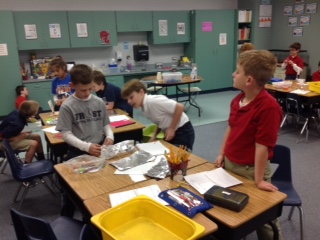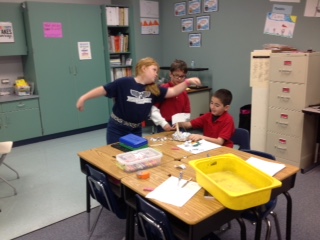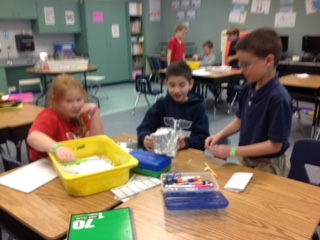Wednesday, February 10, 2016
5th Robotics 2-9-16
5th grade was busy, busy building out their robot prototype and testing it as they built it. Quite a few students were able to start basic programming on the brick (brain) of their lego nxt! Next time we will learn about the functions of the computer software and complete more complex programming on the computer and send our programs to our robot via USB cable.
Tuesday, February 9, 2016
4th Grade: Little Bits Exploration
We explored Little bits circuits this past week as part of a mini-unit called Code Stars. These circuits are great ways to teach about input and output. Learning the ins and out of Little Bits is just the beginning. Students learned the basic circuitry and tried completing the basic challenges like making a light turn on and off with a switch. Then students were encouraged to try their own creations and designs. Students created flashlights, practical joke hand buzzers, and fans that turned on using a pressure sensor. There was much discussion about how circuits are used in everyday items such as computers, coffee pots, cell phone, etc!
In addition to Little Bits circuits, we explored the uses of a robot called Ozobot! This little robot uses visual coding instead of the computer language we have been learning about like that on Code.org. Ozobot has 5 color sensors located on the bottom along with two little wheels. When coding Ozobot we must use lines and color codes of 3-4 colors. We were able to observe Ozobot speed up, slow down, turn at different rotations and other commands as Ozobot traveled across different color codes. We learned that to program Ozobot, we need to learn its color-code language.
In addition to Little Bits circuits, we explored the uses of a robot called Ozobot! This little robot uses visual coding instead of the computer language we have been learning about like that on Code.org. Ozobot has 5 color sensors located on the bottom along with two little wheels. When coding Ozobot we must use lines and color codes of 3-4 colors. We were able to observe Ozobot speed up, slow down, turn at different rotations and other commands as Ozobot traveled across different color codes. We learned that to program Ozobot, we need to learn its color-code language.
Friday, February 5, 2016
3rd Grade Cargo Ships: Engineering Design
Engineering a cargo ship out of a limited set of materials can be a challenge. Our task was to build a ship that could hold as many passengers as possible and also sail as quickly as possible from England (left side of water tub) to the United States (right side of water tub). Several of our boats could hold 100+ and made the Atlantic crossing in 1.1 seconds! We discussed actions we would do differently if we had time to improve our ships. Some of the responses included: make a bigger sail, use popsicle sticks as a frame to keep water from coming in, create more surface area for boat, etc.
Subscribe to:
Comments (Atom)










































